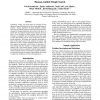Free Online Productivity Tools
i2Speak
i2Symbol
i2OCR
iTex2Img
iWeb2Print
iWeb2Shot
i2Type
iPdf2Split
iPdf2Merge
i2Bopomofo
i2Arabic
i2Style
i2Image
i2PDF
iLatex2Rtf
Sci2ools
AAAI
2000
2000
Human-Guided Simple Search
Scheduling, routing, and layout tasks are examples of hard operations-research problems that have broad application in industry. Typical algorithms for these problems combine some form of gradient descent to find local minima with some strategy for escaping nonoptimal local minima. Our idea is to divide these two subtasks cleanly between human and computer: in our paradigm of human-guided simple search the computer is responsible only for finding local minima using a simple hill-climbing search; using visualization and interaction techniques, the human user identifies promising regions of the search space for the computer to explore, and intervenes to help it escape nonoptimal local minima. We have applied our approach to the problem of capacitated vehicle routing with time windows, a commercially important problem with a rich research history. Despite its simplicity, our prototype system is competitive with the majority of previously reported systems on benchmark academic problems, a...
AAAI 2000 | Hard Operations-research Problems | Intelligent Agents | Local Minima | Nonoptimal Local Minima |
| Added | 01 Nov 2010 |
| Updated | 01 Nov 2010 |
| Type | Conference |
| Year | 2000 |
| Where | AAAI |
| Authors | David Anderson, Emily Anderson, Neal Lesh, Joe Marks, Brian Mirtich, David Ratajczak, Kathy Ryall |
Comments (0)

